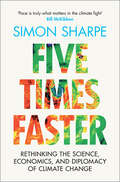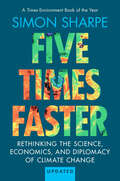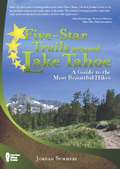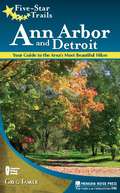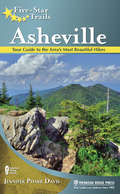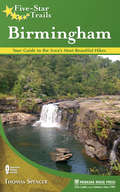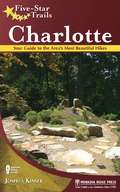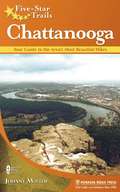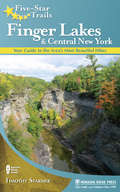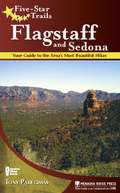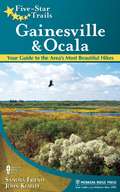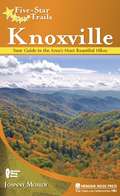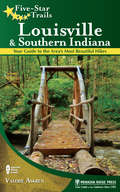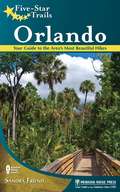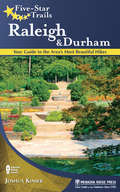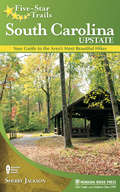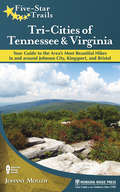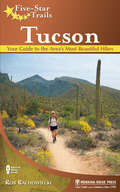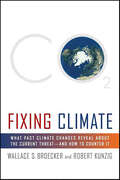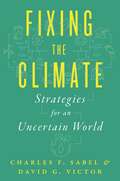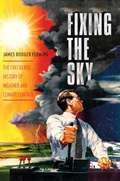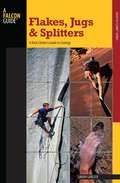- Table View
- List View
Five Times Faster: Rethinking the Science, Economics, and Diplomacy of Climate Change
by Simon SharpeWe need to act five times faster to avoid dangerous climate change. As Greenland melts, Australia burns, and greenhouse gas emissions continue to rise, we think we know who the villains are: oil companies, consumerism, weak political leaders. But what if the real blocks to progress are the ideas and institutions that are supposed to be helping us? Five Times Faster is an inside story from Simon Sharpe, who has spent ten years at the forefront of climate change policy and diplomacy. In our fight to avoid dangerous climate change, science is pulling its punches, diplomacy is picking the wrong battles, and economics has been fighting for the other side. This provocative and engaging book sets out how we should rethink our strategies and reorganise our efforts in the fields of science, economics, and diplomacy, so that we can act fast enough to stay safe.
Five Times Faster: Rethinking the Science, Economics, and Diplomacy of Climate Change – Updated Edition
by Simon SharpeWe need to act five times faster to avoid dangerous climate change. This is an inside story from Simon Sharpe, who has spent ten years at the forefront of climate change policy and diplomacy. In our fight to avoid dangerous climate change, science is pulling its punches, diplomacy is picking the wrong battles, and economics has been fighting for the other side. This provocative and engaging book sets out how we should rethink our strategies and reorganise our efforts in the fields of science, economics, and diplomacy, so that we can act fast enough to stay safe. This edition has been brought up-to-date throughout, and includes a new chapter on how international cooperation on climate change can be reconciled with economic and geopolitical competition. It also includes a response to the question the book has most often provoked: 'How can I help?'
Five-Star Trails around Lake Tahoe
by Jordan SummersCovering the region surrounding the 22-mile long lake, author Jordan Summers guides hikers along 40 of the region's best trails - all located within 25 miles of Lake Tahoe's shoreline.Trekkers can easily find the perfect hike with the complete trail descriptions for 27 dayhike and 13 overnight destinations. An accurate map, directions to the trailhead with coordinates for GPS use, and an elevation profile of each trail prepare hikers with the full picture of the route ahead.Generally intended for outdoors-people of all ages and abilities, Five-Star Trails around Lake Tahoe describes great hikes from the Desolation, Mt. Rose, Granite Chief, and Mokelumne Wilderness areas and along sections of the Pacific Crest National Scenic Trail and portions of the Tahoe Rim Trail. While ranging across forest- and granite-covered terrain to over a dozen peaks and several dozen lakes, hike profiles include details on natural history, geologic features, and places of historic note.With Five-Star Trails around Lake Tahoe, hikers will follow in the footsteps of pioneers such as Kit Carson and the historic Donner Party along the Pony Express Trail and the Emigrant Trail, often with stunning vistas of Lake Tahoe, Emerald Bay, Fallen Leaf Lake, or the Crystal Range.
Five-Star Trails in the Adirondacks
by Timothy StarmerEach hike through the Adirondack Park is rated for scenery, difficulty, trail condition, and accessibility for children. Individual trail maps, elevation profiles, and GPS trailhead coordinates aid in navigating the myriad of unnamed roads. Featured trails range from easy strolls for the family to bone-crunching vertical ascents for the fearless hiker.
Five-Star Trails: Ann Arbor and Detroit
by Greg TaskerEach hike features an individual trail map, elevation profile, and at-a-glance information, helping readers quickly find the perfect trip. Sized to fit in a pocket, the book's detailed trail descriptions will help readers find their way on and off the trail. Driving directions and GPS trailhead coordinates will help with navigating the myriad of unnamed roads. The trails covered range from those best suited to the novice, families, experienced hikers, or backpackers.
Five-Star Trails: Asheville
by Jennifer Pharr DavisFive-Star Trails Asheville provides in-depth trails descriptions, directions, and commentary on what to expect along the way. Each hike features an individual trail map, elevation profile, and at-a-glance information, helping readers quickly find the perfect trip.Sized to fit in a pocket, the book's detailed trail descriptions will help readers find their way on and off the trail. Driving directions and GPS trailhead coordinates will help with navigating the myriad of unnamed roads. The trails covered range from those best suited to the novice, families, experienced hikers, or backpackers.
Five-Star Trails: Birmingham
by Thomas M. SpencerIn the first decade of the 21st century, Birmingham is building again on its natural resources, but this time it's not to fire steel-making smokestacks. Instead, where railroads ran and mines once burrowed into mountains, the healed landscape is being repurposed for hiking and biking. New and expanding venues around the city are providing more opportunities not only to get outside and exercise but also to appreciate the labor and industry that built the city.In Five-Star Trails: Birmingham local author Thomas Spencer leads readers to some of the best hikes around the city. Within a short drive from Birmingham, you can find yourself on an Appalachian mountain peak or on the banks of the Cahaba River as it broadens to snake through the Coastal Plain. You can visit old growth forest in the Sipsey Wilderness or hike down into the "Grand Canyon of the East" at Little River Canyon. And that's only the start. Across this landscape, you'll find a level of diversity of plant and animal species, some rare and endangered, that rivals anywhere in the North America.
Five-Star Trails: Charlotte
by Joshua KinserFive-Star Trails: Charlotte is a handy guide for area residents, vacationers seeking outdoor fun, and for business travelers with a free afternoon. With a diverse collection of hiking routes, the book offers choices for everyone from solo trekkers to companions to families with either youngsters or oldsters to consider.Researched, experienced, and written by a local author, the guide provides in-depth trail descriptions, directions, and commentary on what to expect along the way. Each hike features an individual trail map, elevation profile, and at-a-glance key info, helping readers quickly determine the perfect trip for them when they are ready to head out the door.Sized to fit in a pocket, the book is convenient to keep in the car or toss into a backpack. Driving directions direct hikers to the nearest trailhead parking areas, and GPS trailhead coordinates get them to the start of the trail.
Five-Star Trails: Chattanooga
by Johnny MolloyFive-Star Trails: Chattanooga is a handy guide for area residents, vacationers seeking outdoor fun, and for business travelers with a free afternoon. With a diverse collection of hiking routes, the book offers choices for everyone from solo trekkers to companions to families with either youngsters or oldsters to consider.This book profiles close-in urban and suburban locations that can satiate scenery-hungry residents and also offers routes of superlative beauty in the adjacent local, state, and national parks. All this adds up to a hiker's nirvana.Chattanooga is ideally situated to enjoy some of the Southeast's best scenery. To the east and south are two huge tracts of sublime and primitive national forest land -- the Chattahoochee and the Cherokee -- much within an easy drive of Chattanooga. The national forests also offer camping, hunting, fishing, nature study, and more. To the west rises the Cumberland Plateau, with its finest features protected under the umbrella of Tennessee's state park system, centered by the Volunteer State's master path, the Cumberland Plateau. The geologically fascinating Cumberland offers hiking routes along rushing rivers, deep gorges, wild waterfalls, and other rock features.Other parks lie within the bounds of Alabama and Georgia, from Little River Canyon to Cloudland Canyon to Chickamauga Battlefield. Lookout Mountain and other local hiking destinations only add to the possibilities. The wide variety of trails, distances, difficulties, and destinations will suit any hiker's mood and company.Researched, experienced, and written by a local author, the guide provides in-depth trail descriptions, directions, and commentary on what to expect along the way. Each hike features an individual trail map, elevation profile, and at-a-glance key info, helping readers quickly determine the perfect trip for them when they are ready to head out the door.Sized to fit in a pocket, the book is convenient to keep in the car or toss into a backpack. Driving directions direct hikers to the nearest trailhead parking areas, and GPS trailhead coordinates get them to the start of the trail.
Five-Star Trails: Columbus
by Robert LoewendickFive-Star Trails: Columbus is the most current and comprehensive guide to hiking the area and rates hikes on the following factors: scenery, trail condition, difficulty, appropriateness for children, and solitude. Each hikes also includes detailed landmarks, flora, fauna, and local history. In this Columbus guide, an impressive collection of routes ranges north, east, south, and west from the metro center, as well as within the urban setting. This capital city is rich in metro parks, natural areas and preserves, state parks, and state forests. And this diversity of hiking terrain invites all levels of abilities and skills. Thus, this guidebook is geared not only to avid trekkers seeking more challenge than a paved neighborhood path, but also to families and senior citizens. Outdoor enthusiasts of every stripe will have reason to grab this book and, well, take a hike. Sized for easy carrying or tossing into a backpack, this handy guide will quickly become a treasured resource among Columbus locals and visitors alike.
Five-Star Trails: Finger Lakes and Central New York
by Timothy StarmerThe Finger Lakes and Central New York are not known for rugged mountains and their panoramic vistas which are so commonly sought in the Adirondacks to the north. They hardly could be - the area was scoured clean by glaciers millennia ago. But don't let that fool you, the region is full of natural wonders of its own. Instead of mountains and ridges, the region is known for rolling drumlins, an abundance of scenic gorges, quiet woodlands, beautiful waterfalls and picturesque lakes. The trails included in Five-Star Trails: New York's Finger Lakes and Central Region feature a broad mixture of these landscapes and were carefully selected to give the most varied but also rewarding experience when picking a trail.An assortment of state parks, local parks, state forests, conservancy areas, wildlife preserves, and nature centers riddle the region, and choice selections from each means you can find a trail that suits your preference for how civil or wild you might desire. Trails for all experience levels are included and provide opportunities for adventure for novice and expert alike.Some of these trails are well known and their inclusion in this new guide is no surprise. However far more are lesser known and a little more off the beaten path. Though these trails are not hard to find they are hard to find any real details about. What should you expect along the trail? Is the terrain rough? Will there be interesting things along the trip? Is the trail appropriate and/or safe for children? Well that lack of information is no longer an issue.Each trail has been thoroughly researched, recently hiked and includes a detailed description, trail profiles and map. At a glance ratings in important categories such as Scenery, Trail Condition, Difficulty, Solitude and appropriateness for children let you quickly select a trail that fits your tastes and ability. Other useful information such as fees, restrictions for dogs on the trail as well as advice on when to visit offers you the best information so you can plan your trip with ease. Sized to fit in a pocket, this guide is convenient to keep in the car or toss into a backpack. Driving directions direct hikers to the nearest trailhead parking areas, and GPS trailhead coordinates get them to the start of the trail.
Five-Star Trails: Flagstaff and Sedona
by Tony PadegimasEach hike features an individual trail map, elevation profile, and at-a-glance information, helping readers quickly find the perfect trip. Sized to fit in a pocket, the book's detailed trail descriptions will help readers find their way on and off the trail. Driving directions and GPS trailhead coordinates will help with navigating the myriad of unnamed roads. The trails covered range from those best suited to the novice, families, experienced hikers, or backpackers.
Five-Star Trails: Gainesville & Ocala
by John Keatley Sandra FriendWhile polar opposites in many ways - hip college town versus retiree mecca - both Gainesville and Ocala, only 35 miles apart, share a love of the outdoors. Student clubs from the University of Florida hike the same trails as Volksmarch groups from the Villages, enjoying wilderness immersion in the Ocala National Forest and scrambles on rugged terrain along the Cross Florida Greenway. With several hundred miles of trails throughout the region to choose from, Five-Star Trails: Gainesville & Ocala helps you find the best. Authored by Florida hiking expert and long-time Ocala resident Sandra Friend, with 40-year Eagle Scout and Florida Trail Association life member John Keatley, this handy guide provides a fresh perspective on the region's ever-expanding array of hiking trails. Find urban places for reflection like Sholom Park, a carefully manicured woodlands in a retirement community, and Bivens Arm Nature Park, surrounding a marsh in Gainesville; both feature inspirational quotes and places to relax along their trails. Explore the vast longleaf pine flatwoods of the Ocala National Forest on the Florida Trail near Lake Delancy and the shady swamp forests of Goethe State Forest along the Big Cypress Trail. See more alligators than you've ever seen in your life in the home of the Gators along the La Chua Trail at Paynes Prairie Preserve State Park. Covering more than 35 hikes across a three-county region, all within an hour's drive of either city, Five-Star Trails: Gainesville & Ocala gives you a reason to get outdoors now.Hikes are rated and highlighted according to their strengths from five perspectives: scenery, trail conditions, good for children, difficulty, and solitude. Author recommendations for best hikes in other categories - including wildlife watching, ancient trees, Florida Trail segments, geology, kid-friendly, and dog-friendly hikes - make it easy to choose an adventure at a glance. Add in Sandra Friend's extensive knowledge of habitats, wildlife, wildflowers, and local history, and you'll be glad to have Five-Star Trails: Gainesville & Ocala as your guide to exploring the region's outdoors.
Five-Star Trails: Knoxville
by Johnny MolloyLike others in the Five-Star Trails series, this book features up to 40 day-hikes, ranging from 1 mile to 12 miles, in and near a midsize city-in this case, Knoxville.The author has carefully chosen each hike to create a collection of routes suitable for a varied, but primarily local, outdoors audience. Based on the author's extensive and intimate knowledge of the region, some of the hikes represent a combination of two or more trails that create a unique route.As a distinguishing feature of the series, as signaled by the Five-Star series title, each entry displays ratings of one to five stars in five categories for that hike. Those categories are: Scenery Level of Difficulty Trail Conditions Degree of Solitude Appropriateness for ChildrenThe book's overview map provides a quick visual summation of the hikes' locations within the greater Knoxville area. Then, individually, each hike features an easy-to-follow trail map, elevation profile, at-a-glance information, and narrative description. The main text for each entry provides details about the route to follow. It also focuses on the most notable aspects of that route: for some, it may be the panoramic view; for others, a bit of local history
Five-Star Trails: Louisville and Southern Indiana
by Valerie AskrenKnown as the City of Parks, Louisville has long valued the natural landscape and the provisioning of outdoor recreation. In 1891 Frederick Law Olmsted, the father of American landscape architecture, was commissioned to develop an extensive park system for Louisville that eventually included 18 parks and 6 interconnecting parkways. Since that time, Louisville has continued to invest resources to build a first-class park system. Nestled within the Ohio Valley, and bordered by the knobs region to the south and the heavily forested areas of Indiana to the north, Louisville lies at the heart of an endless array of hiking opportunities.Five-Star Trails: Louisville showcases many of the hiking trails and walking paths within the city or within easy driving distance in central Kentucky and southern Indiana. Designed specifically for day trips, this book includes several of the area's most popular parks, as well as many of the lesser-known hiking trails in nature preserves, wildlife management areas, and national forests.
Five-Star Trails: Orlando
by Sandra FriendFive-Star Trails: Orlando is a handy guide for area residents, vacationers seeking outdoor fun, and for business travelers with a free afternoon. With a diverse collection of hiking routes, the book offers choices for everyone from solo trekkers to companions to families with either youngsters or oldsters to consider.Researched, experienced, and written by a local author, the guide provides in-depth trail descriptions, directions, and commentary on what to expect along the way. Each hike features an individual trail map, elevation profile, and at-a-glance key info, helping readers quickly determine the perfect trip for them when they are ready to head out the door.Sized to fit in a pocket, the book is convenient to keep in the car or toss into a backpack. Driving directions direct hikers to the nearest trailhead parking areas, and GPS trailhead coordinates get them to the start of the trail.
Five-Star Trails: Raleigh and Durham
by Joshua KinserFive-Star Trails: Raleigh and Durham is a guide to the best day-hiking trails within a two-hour drive of the urban areas of Raleigh and Durham. Raleigh is North Carolina's capital and an anchor for the state's famous Research Triangle that includes Durham and Chapel Hill. Amid this metropolitan complex that also embraces Cary, Apex, and Wake Forest-home to more than 1.7 million people-the author leads readers to myriad places for scenic beauty, to sites of historic significance, and to neighborhoods that showcase the charms of urban life. All of the routes stay true to the book's "Five-Star Trails" title, based on the book series' rating system for scenery, trail condition, suitability for children, difficulty level, and solitude. To be selected for the book, each trail must truly shine in one or more of those areas while, at the same time, all of the trails combine to offer diversity for a wide range of hikers. Thus, this is the guidebook for a hiker seeking an arduous climb to a scenic overlook as much as it is for a weekend walker who wants an easy trail for his or her family.
Five-Star Trails: South Carolina Upstate
by Sherry JacksonThe South Carolina Upcountry is gaining more popularity and people visiting will need to know how to discover all it has to offer. Outdoor activities here abound and there are a good variety of trails for hikers of all levels. From waterfalls to amazing mountain views, each trail offers hikers an incredible experience. Since the Upcountry is relatively "undiscovered", there are very few books that have a true compilation of hikes in the area. Five-Star Trails: South Carolina Upstate will bring together those hiking trails that offer a "five star" experience.Each trail has been thoroughly researched, recently hiked and includes a detailed description, trail profiles and map. At a glance ratings in important categories such as Scenery, Trail Condition, Difficulty, Solitude and appropriateness for children let you quickly select a trail that fits your tastes and ability. Other useful information such as fees, restrictions for dogs on the trail as well as advice on when to visit offers you the best information so you can plan your trip with ease. Five-Star Trails: South Carolina Upstate provides directions and commentary for each trail on what to expect along the way, making it more than just an average guidebook. This guide will lead hikers off the beaten path to find exceptional beauty as well as peace of mind. The diversity in terrain invites all levels of abilities and skills. Outdoor enthusiasts of every level will have reason to grab this guide and take a hike.This book offers easy-to-moderate trails that are within driving distance from a reader's workplace or home in the South Carolina Upstate. Without this book, they might miss the hidden hiking treasures of the area, but with the expert help of Sherry Jackson, readers will enjoy the region's best trails!
Five-Star Trails: Tri-Cities of Tennessee and Virginia
by Johnny MolloyFive-Star Trails: Tri-Cities of Tennessee and Virginia details the 40 best hikes in and around Johnson City, Kingsport, and Bristol as well as the surrounding areas of Abingdon, Elizabethton, Greenville, and Rogersville. Drawing from a wealth of trails on vast public lands, the mosaic of hikes featured reflects the wide variety of terrain in the greater Tri-Cities, from high mountains to the east and south to the historic walks in Tennessee state parks. The Appalachian Trail also provides nearly 70 miles of quality hiking around the Tri-Cities. Authored by Johnny Molloy, the most experienced guidebook author in the field today, this guide has something for everyone, from a leisurely weekend stroll to advanced treks into the Appalachians.
Five-Star Trails: Tucson
by Rob RachowieckiTucson lies in a saguaro-studded desert basin surrounded by four mountain ranges and book-ended by two national parks. In an hour you can drive from an arid canyon in the Arizona-Sonora desert to a pine-forested mountain at 9000 feet. Hiking trails are plentiful and as varied as the terrain. Five-Star Trails: Tucson by Rob Rachowiecki guides you to diverse hikes suitable for anyone from wheelchair-using nature lovers to hikers looking for an all-day workout.Each trail has been thoroughly researched, recently hiked and includes a detailed description, trail profiles and map. At a glance categorical ratings, such as Scenery, Trail Condition, Difficulty, Solitude and kid-friendliness, let you quickly select a trail that fits your tastes and ability. Other key information such as fees, restrictions for dogs on the trail as well as advice on when to visit offers you the best information so you can plan your trip with ease.Sized to fit in a pocket, this guide is convenient to keep in the car or toss into a backpack. Driving directions direct hikers to the nearest trailhead parking areas, and GPS trailhead coordinates get them to the start of the trail.
Fixing Climate: What Past Climate Changes Reveal About the Current Threat—and How to Counter It
by Robert Kunzig Wallace S. BroeckerDealing with the Root Cause of Global Warming Calls for New Remedies, Says ExpertThe product of a unique collaboration between a pioneering earth scientist and an award winning science writer, FixingClimate takes an unconventional approach to the vitally important issue of global warming. Wallace S. Broecker, a longtime researcher at Columbia University's Lamont-Doherty Earth Observatory, warned about the possible consequences of global warming decades before the concept entered popular consciousness. Hooked on climate studies since his student days, he has learned, largely through his own findings, that climate changes—naturally, dramatically, and rarely benignly. He also knows from experience that when mankind pushes nature as we are currently doing by dumping some sixty to seventy million metric tons of carbon dioxide into the atmosphere every day, climate will change even more dramatically and less benignly. As Broecker points out, if a well-meaning fairy godmother were to turn us all into energysaving paragons at the stroke of midnight tonight, the resulting reduction in atmospheric carbon dioxide might lessen but could not turn aside the great warming tide now headed our way. There is, nonetheless, a glimmer of hope in the development of new technologies that are directed not only at the reduction of carbon dioxide output but also at its harmless disposal. Told by skilled science journalist Robert Kunzig, Fixing Climate is a timely and informative story that makes for riveting reading
Fixing the Climate: Strategies for an Uncertain World
by David G. Victor Charles F. SabelSolving the global climate crisis through local partnerships and experimentationGlobal climate diplomacy—from the Kyoto Protocol to the Paris Agreement—is not working. Despite decades of sustained negotiations by world leaders, the climate crisis continues to worsen. The solution is within our grasp—but we will not achieve it through top-down global treaties or grand bargains among nations.Charles Sabel and David Victor explain why the profound transformations needed for deep cuts in emissions must arise locally, with government and business working together to experiment with new technologies, quickly learn the best solutions, and spread that information globally. Sabel and Victor show how some of the most iconic successes in environmental policy were products of this experimentalist approach to problem solving, such as the Montreal Protocol on the ozone layer, the rise of electric vehicles, and Europe’s success in controlling water pollution. They argue that the Paris Agreement is at best an umbrella under which local experimentation can push the technological frontier and help societies around the world learn how to deploy the technologies and policies needed to tackle this daunting global problem.A visionary book that fundamentally reorients our thinking about the climate crisis, Fixing the Climate is a road map to institutional design that can finally lead to self-sustaining reductions in emissions that years of global diplomacy have failed to deliver.
Fixing the Sky: The Checkered History of Weather and Climate Control (Columbia Studies in International and Global History)
by James FlemingAs alarm over global warming spreads, a radical idea is gaining momentum. Forget cuts in greenhouse gas emissions, some scientists argue. Instead, bounce sunlight back into space by pumping reflective nanoparticles into the atmosphere. Launch mirrors into orbit around the Earth. Make clouds thicker and brighter to create a "planetary thermostat."These ideas might sound like science fiction, but in fact they are part of a very old story. For more than a century, scientists, soldiers, and charlatans have tried to manipulate weather and climate, and like them, today's climate engineers wildly exaggerate what is possible. Scarcely considering the political, military, and ethical implications of managing the world's climate, these individuals hatch schemes with potential consequences that far outweigh anything their predecessors might have faced.Showing what can happen when fixing the sky becomes a dangerous experiment in pseudoscience, James Rodger Fleming traces the tragicomic history of the rainmakers, rain fakers, weather warriors, and climate engineers who have been both full of ideas and full of themselves. Weaving together stories from elite science, cutting-edge technology, and popular culture, Fleming examines issues of health and navigation in the 1830s, drought in the 1890s, aircraft safety in the 1930s, and world conflict since the 1940s. Killer hurricanes, ozone depletion, and global warming fuel the fantasies of today. Based on archival and primary research, Fleming's original story speaks to anyone who has a stake in sustaining the planet.
Flag of Freedom
by Seth Hunter1797: Britain stands alone against the forces of Revolutionary France. A victorious French Army, led by the youthful Napoleon Bonaparte, is poised to invade Britain. And in his country's darkest hour, Captain Nathan Peake finds himself imprisoned by his own side on the Rock of Gibraltar and charged with treason. To prove his innocence, Nathan must uncover the great deception that masks the French war aims. Is the great armada being assembled in Toulon bound for the shores of Great Britain or Egypt? His secret mission to discover the truth about Napoleon's invasion plans will hurl him into two of the greatest battles of the 18th century.
Flakes, Jugs, and Splitters: A Rock Climber's Guide to Geology (How To Climb Series)
by Sarah GarlickRock climbers have an inherent interest in geology. For some, it&’s about knowing what gear to use or how to avoid rotten bands of rock. For others, it&’s about finding the next hot-spot boulder field, or understanding why their local crag exists. For most of them, curiosity about rocks comes as naturally as their desire to climb them. Geology is the fundamental control on the sport, and yet there are no practical guides for the climber interested in rocks. Flakes, Jugs, and Splitters fills the niche. With an informal Q&A format and fun, informative language, it brings the often esoteric science of geology into the hands of rock climbers. Covering topics from how to use a geologic map to finding new crags, from why Europe has the best limestone to how El Capitan&’s North America Wall got its name, this book has a fact for every climber&’s ponderings. Top-quality photographs of worldwide destinations and easy-to-read artist&’s renderings of geologic concepts make it as visually engaging as it is entertaining and edifying.
